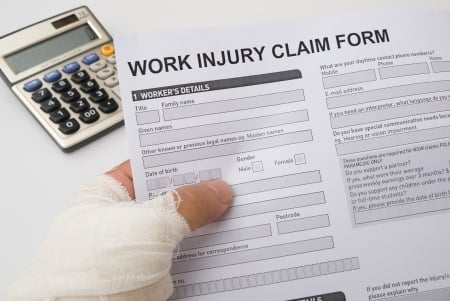No, it’s not the latest Hollywood movie about guys and their need for speed. For those of you who know me well, sarcasm is one of my most endearing traits! So as a follow up to Tim Leman’s New Year Safety blog, I thought it would be fun to share my top driving annoyances. While no one reading this is guilty of any of these driving violations, I’m sure we all can think of someone who is. Not surprising, many of these habits cause the majority of claims each year.
2 min read
The Fast Can Make Me Furious
By Gibson on Jan 13, 2014 2:00:00 AM
Topics: Commercial Insurance Risk Management Claims Personal Insurance & Risk Management Workers' Compensation
2 min read
Tips for Preventing Workers Compensation Fraud
By Gibson on Jan 6, 2014 3:27:00 AM
Workers compensation fraud can be a major expense and therefore a significant risk to any employer. However, it is easier to prevent that you think. With a few easy steps, you can help prevent fraud from happening within your company.
Topics: Claims Workers' Compensation
1 min read
Three Benefits of a Return-to-Work Program
By Gibson on Dec 11, 2013 3:28:00 AM
A return-to-work program has many benefits, and the pros far outweigh the cons! The proper understanding and communication of the rationale for a return-to-work program will help make the naysayers change their minds. Consider these three benefits:
Topics: Commercial Insurance Construction Workers' Compensation
2 min read
Tips for Preventing Workers Compensation Fraud
By Gibson on Nov 27, 2013 3:09:00 AM
Workers’ compensation fraud can be a major expense and therefore a significant risk to any employer. However, it is easier to prevent than you think. With a few easy steps, you can help prevent fraud from happening within your company.
Monitor The Trends Of Workers’ Comp Claims
Topics: Claims Workers' Compensation
3 min read
What Workers Compensation Reform Means For You
By Gibson on Aug 21, 2013 8:01:00 AM
Workers’ Compensation Reform achieved a huge victory earlier this summer with the signing into law of HB 1320, an act that the American Insurance Association feels ‘addresses problems which have been steadily mounting in Indiana for years.’
Indiana Governor Mike Pence penned the legislation which, effective of July 1, ensures a fee schedule with a maximum reimbursement rate of 200% of the Medicare rate for treatments and procedures to workers’ compensation claimants by medical service providers. While those are the provisions of the new legislation in a nutshell, there are plenty of other considerations Businesses need to be aware of, particularly considering the imminent arrival of Health Care Reform.
What Exactly Is Workers Compensation?
Topics: Employee Benefits Workers' Compensation
2 min read
Employee Burnout
By Gibson on Aug 7, 2013 5:00:00 AM
In today’s world there is so much emphasis on doing more with less. This obviously has its perks, but it also has a significant negative impact that cannot be overlooked. Employees who are pushed to the max are at risk of being overstressed and ultimately burning out. Burnout reduces productivity and takes a toll on individual’s health.
Topics: Risk Management Employee Benefits Workers' Compensation
2 min read
Wellness ROI - Are You Having The Right Conversation?
By Nicole Fallowfield on Jul 29, 2013 3:30:00 AM
Employers should believe that healthier employees are more productive employees. Studies prove this! Emphasizing health AND changing the culture within the workplace to support healthier lifestyles is worth the effort. Any ROI is icing on the cake.
Topics: Risk Management Employee Benefits Health Risk Management Workers' Compensation
1 min read
What’s Being Done To Change The Workers’ Compensation System In Indiana?
By Gibson on May 29, 2013 9:00:00 AM
The Indiana General Assembly passed and Gov. Pence has signed into law HB 1320, which introduces a fee schedule into Indiana’s workers’ compensation statute. Over 25 states have enacted fee schedule legislation since the mid-1990s to impose a limit or cap on medical reimbursement. Insurers generally favor fee schedules while medical providers generally oppose it. Indiana will now have a schedule set at 200% of Medicare reimbursement levels.
Prior to this passing, Indiana had relied on a “usual and customary” method, which had many pitfalls. Both the Workers’ Compensation Research Institute (WCRI) and theNational Council on Compensation Insurance (NCCI) have published studies showing how, overall, “usual and customary” states had higher comparable medical costs and higher rates of increases in cost.
Topics: Commercial Insurance Risk Management Workers' Compensation
2 min read
Why Are Workers’ Compensation Rates Increasing?
By Gibson on May 27, 2013 8:00:00 AM
1. Insurer investment returns
The financial crisis of 2008 caused insurers to write down their investment portfolios and reallocate seeking higher returns. However, with a prevalence of low-yielding investments, attractive returns were not possible. Furthermore, credit quality impaired insurer’s massive corporate bonds holdings. For insurers with an international footprint there was also the impact of the sovereign debt crisis in Europe and the drain on surplus caused by 2011 delivering one of the worst worldwide catastrophic loss years on record. Interest rates on 10-year treasury notes have been following a downward trend for over a decade and are now at all-time record lows. Since roughly 80% of the property-casualty industry’s bond/cash investments are in 10-year or shorter durations, most insurer portfolios will have low-yielding bonds for years to come. In addition, the recession reduced demand for workers’ comp (demand = payroll).
Topics: Commercial Insurance Workers' Compensation
2 min read
Workers’ Compensation Claims Are All About People, The Human Capital Of Business.
By Gibson on May 22, 2013 4:00:00 AM
Unhealthy, unproductive, unengaged employees are among an employer’s largest strategic risks. Employers have seen this in health insurance rates for years. Now, the workers’ compensation insurers are starting to pay attention. Workers’ compensation insurers are coming to the realization that safety programs aren’t enough. Yes, these programs are necessary and beneficial, but they don’t address the health and wellness of each individual employee and often fail to impact employee engagement focusing instead on physical hazards (e.g. machine guarding). Insurers recognize the changing demographic of today’s employees: an aging workforce that’s retiring at an older age and more likely to be overweight. This is leading to comorbid health issues like hypertension, diabetes, and high cholesterol. Taken together, these elements have the makings of a perfect storm.
Imagine this scenario: Mary is in the supply room getting a box of paper. It falls on and injures her foot. Her employer sends an incident report to their workers’ compensation carrier. A few days later, Mary’s foot is still bothering her with an ulcer forming at the impact site. Mary gets medical treatment, but the ulcer won’t heal. Fast-forward a few months to the possibility of Mary losing her foot - a complication of untreated diabetes. Of course, this is an extreme example, but it’s one that’s becoming a trend.





